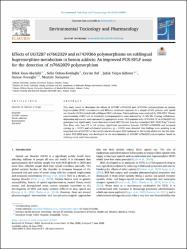Effects of UGT2B7 rs7662029 and rs7439366 polymorphisms on sublingual buprenorphine metabolism in heroin addicts: An improved PCR-RFLP assay for the detection of rs7662029 polymorphism

View/
Access
info:eu-repo/semantics/openAccessDate
2022Author
Kaya-Akyüzlü, DilekÖzkan-Kotiloğlu, Selin
Bal, Ceylan
Yalçın -Şahiner, Şafak
Avcıoğlu, Gamze
Danışman, Mustafa
Metadata
Show full item recordCitation
Kaya-Akyüzlü, D., Özkan-Kotiloğlu, S., Bal, C., Yalçın-Şahiner, Ş., Avcıoğlu, G., & Danışman, M. (2022). Effects of UGT2B7 rs7662029 and rs7439366 polymorphisms on sublingual buprenorphine metabolism in heroin addicts: an improved PCR-RFLP assay for the detection of rs7662029 polymorphism. Environmental Toxicology and Pharmacology, 103902.Abstract
This study aimed to determine the effects of UGT2B7 rs7662029 and rs7439366 polymorphisms on plasma buprenorphine (BUP) concentration and different treatment responses in a sample of 109 patients with opioid use disorder (OUD) treated with sublingual BUP/naloxone. Polymorphisms were analysed by PCR-RFLP. Plasma concentrations of BUP and its metabolite norbuprenorphine were detected by LC-MS/MS. Craving, withdrawal, depression and anxiety were measured by appropriate scales. OUD patients with rs7439366 CC or rs7662029 GG genotypes had significantly lower dose-normalized (BUP/D) and dose/kg-normalized BUP (BUP/D.kg(-1)) levels than those who were CT or AA carriers. Significant associations between UGT2B7 rs7662029 and increased craving (p = 0.037) and withdrawal symptoms (p = 0.029) were detected. Our findings were pointing to an important role of UGT2B7 in the metabolism of sublingual BUP/naloxone in the heroin addicts for the first time. A novel PCR-RFLP assay was developed for the determination of UGT2B7 rs7662029 polymorphism, based on utilizing novel restriction enzyme.

















